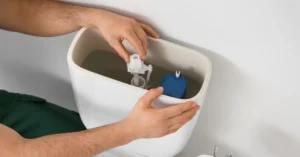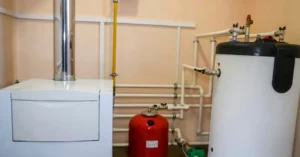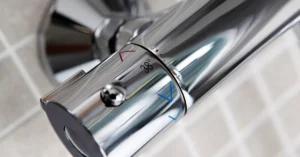Plumbing emergencies are stressful no matter where you live. But if you’re a homeowner in San Diego, you might see unique issues related to the region’s climate and water supply.
This tutorial will walk you through common plumbing problems and solutions for San Diego homes, showing you what you can fix yourself and when you’ll want to call in the pros. Let’s dive in.
1. Understand typical local issues
In San Diego, the coastal climate and older housing stock can create a few specific problems. Before you jump into any repairs, it’s a good idea to recognize the usual trouble spots.
Hard water challenges
Many parts of San Diego have relatively hard water. Hard water simply means it carries higher levels of minerals like calcium and magnesium. Over time, these minerals form scale (chalky deposits) inside your pipes and fixtures. The result can be reduced water pressure, clogged faucets, or that whitish buildup on showerheads.
Professional water treatment systems can help address hard water issues throughout your home, protecting your pipes and fixtures from mineral damage.
Aging pipes in older homes
Some San Diego neighborhoods like Point Loma (92106), La Mesa (91942), and areas of Chula Vista (91910) feature classic homes built decades ago. Their charm is wonderful, yet these properties often come with older pipes made of galvanized steel or sometimes even clay lines for drainage. Corrosion and tree root intrusion can be common, so you may notice rusty water, recurring leaks, or slow-running drains.
When major pipe problems arise, modern pipelining and repiping techniques can restore your plumbing system with minimal disruption to your home.
Effects of sunshine and temperature fluctuations
Although San Diego’s weather is famously mild, we still get temperature swings, especially inland. Over years, repeated expansion and contraction of pipes can loosen your connections, leading to drips or bursts if you’re not paying attention.
2. Gather the essential tools
Before you fix anything, round up a small home plumbing toolkit. Having these items on hand spares you multiple trips to the hardware store.
Essential plumbing tools:
- Plunger (cup and flange types)
- Adjustable wrench
- Basin wrench (for tightening hard-to-reach nuts under sinks)
- Pipe wrench (heavier duty for stubborn fixtures)
- Plumber’s tape (also called Teflon tape)
- Plumber’s putty
- A bucket and some old towels
With these basics in your toolbox, you’ll be ready for most do-it-yourself tasks. If you’re dealing with a bigger issue, you’ll likely need more advanced equipment, plus the expertise of certified pros.
The American Red Cross provides home emergency preparedness tips that include basic plumbing tools every homeowner should have.
3. Tackle clogged drains step by step
Clogged drains rank near the top of plumbing annoyances in San Diego. Minerals from hard water, combined with the usual soap scum and debris, can gum up your pipes. Here’s a straightforward way to clear your sink or tub without calling someone right away.
3.1 Use a plunger
- Fill the sink or tub with a few inches of water
- Position your plunger so it forms a tight seal around the drain hole
- Plunge up and down vigorously for 20 seconds or so
- Lift the plunger to see whether the water drains
If the clog dislodges, you’ll hear a satisfying gurgle and watch the water swirl away. Problem solved. If not, move on to the next step.
3.2 Try a homemade drain cleaner
If plunging doesn’t do the trick, you can concoct a quick solution using pantry ingredients:
- Pour a half cup of baking soda down the drain
- Follow with a cup of white vinegar
- Let the fizzing reaction loosen the blockage for about 10 minutes
- Flush it with boiling water
In many cases, this breakdown of debris can clear up minor clogs. If your drain is still stubbornly stuck, you might consider a drain snake or an auger. However, if you find yourself repeatedly fighting the same clog, you could have an underlying problem, like intrusive roots or a damaged pipe. That’s when professional drain cleaning and repair is the wiser route.
For more insights on effective drain cleaning methods, check out our test results on popular drain cleaning hacks that actually work in Southern California homes.
4. Fix low water pressure issues
Does your shower trickle instead of spray? Do faucets take ages to fill a simple glass of water? Low water pressure can be annoying. In San Diego, mineral buildup and hidden leaks both play a starring role. Try these steps to get that water flowing again.
4.1 Clean faucet aerators
Minerals love to settle in faucet aerators (the small screen at the tip). Here’s a quick fix:
- Unscrew the aerator from your faucet
- Soak it in white vinegar for at least 30 minutes to dissolve deposits
- Rinse and scrub gently with a toothbrush
- Reattach and test your faucet
4.2 Check for hidden leaks
If cleaning aerators doesn’t return you to normal pressure, you may have a leak. Look for damp patches of ground in your yard, unexpectedly high water bills, or the sound of running water even when everything’s off.
Leak detection steps:
- Walk your property and check valve boxes or hose connections
- Open cabinets under sinks to spot any drip marks
- If your water meter continues to move when you’ve shut every faucet and toilet, you probably have a sneaky leak
When in doubt, a licensed plumbing repair expert can help you locate any leaking lines. Professional camera line inspection services can pinpoint exactly where leaks are occurring without destructive digging.
5. Protect your water quality
Many homeowners worry about water cleanliness, especially in areas known for higher mineral content. You might notice chalky residue around your tub or a slight unfamiliar taste. Here are ways to keep your home’s water supply crisp and clean.
5.1 Install a water softener
A water softener is a device that removes or neutralizes the minerals in your water. It’s particularly handy in places like San Diego. Whether you choose a salt-based or salt-free system, a softener can:
- Reduce scale buildup in pipes
- Make your soaps and detergents work better
- Lengthen the lifespan of appliances like dishwashers and washing machines
Professional water treatment systems can be customized to address your specific water quality needs.
5.2 Use under-sink filters
If you’re mostly concerned about drinking water, an under-sink filtration system could be simpler than a whole-home softener. These filters are easy to install, plus they won’t add to your monthly utility costs in a big way. By cleaning the water at the tap, you see an immediate difference in taste and clarity.
5.3 Flush your water heater
Over time, scale accumulates in your hot water heater. If you hear rumbling or popping sounds, you probably have some sediment buildup. To flush:
- Turn off the heater’s power or gas supply
- Connect a garden hose to the drain valve and run it outside or into a bucket
- Open the tank’s drain and let the water flow until it runs clear
- Close the valve, remove the hose, and restart the unit
Flushing once or twice a year can lengthen your heater’s lifespan and keep your hot water at full strength.
6. Stop leaks and drips
Little leaks can balloon into big headaches if ignored. In San Diego’s older neighborhoods like Oceanside (92054) and Coronado (92118), a worn-out washer or corroded valve is often the culprit. Here’s your step-by-step approach to minor leaks.
6.1 Turn off the water
Find your home’s main shut-off valve, usually in the garage or near the front foundation. Twist it clockwise to cut off the supply. This prevents further water damage while you work on the repair.
6.2 Inspect the fixture
Common leak sources:
- Sinks and faucets: Check washers or O-rings for wear
- Toilets: Peel back the tank lid and look at the fill valve, flapper, and flush lever
- Outdoor hoses: Inspect washers within the hose coupling
If you see obvious cracks or tears, replacing those worn parts often solves the problem. For faucets, you can typically unscrew the handle, remove the cartridge, and swap in a fresh one from the hardware store.
6.3 Apply sealants where needed
When you reassemble, add a layer of plumber’s tape (Teflon tape) on threaded connections to create a watertight seal. Use plumber’s putty around sink drains. These little steps help prevent re-drips and preserve water pressure.
If you’re noticing water damage in your walls or ceiling, it’s likely you have a pipe issue behind the scenes. This might call for advanced plumbing repair. Sometimes you need to open up drywall, replace damaged pipe sections, and restore the area afterward. In that case, it’s best to call for emergency services if it’s flooding or heavily leaking. Quick action can save you big bucks on renovations down the road.
For immediate guidance on leak emergencies, check out our guide on the best emergency steps to take when you discover a leak in your San Diego home.
7. Tame toilet troubles
From constant running to a total blockage, toilet issues can be surprisingly disruptive. Here’s how to deal with two of the most common.
7.1 Running toilet
When water keeps rushing into the bowl, you’re wasting gallons by the hour. To fix:
- Pop the lid off and look at the flapper (the rubber piece that seals the flush valve)
- If it’s warped or brittle, swap it for a new flapper from the hardware store (they’re inexpensive)
- Adjust the chain so there’s a little slack. If the chain is too tight, the flapper won’t seat properly
Sometimes the float arm or fill valve might need a tweak. Ensure the water level is an inch or so below the top of the overflow tube. A quick bend of the float arm or slight turn of an adjustment screw will often fix it.
7.2 Complete clog
For a stubborn toilet clog, use a flange plunger (the kind with a narrow extension on the bottom). Remember to:
- Make sure there’s enough water in the bowl to cover the plunger rim
- Press and plunge in an up-and-down motion without breaking the seal
- Repeat a few times until water starts to drain away
If plunging fails, harness a toilet auger. Insert it gently into the drain opening, crank the handle and break the blockage. Be mindful not to push too hard and damage the porcelain. If the clog persists, contacting a licensed plumber might be easier than driving yourself bonkers.
8. Differentiate DIY from professional help
You can tackle a surprising number of plumbing fixes on your own. But there’s a line between a feasible weekend project and a job for the experts. How do you know when to step aside?
Call professionals for:
- Flooding or sewer backflow: Sewer problems can be hazardous if not handled properly
- Major damage to pipes: If your home’s older piping is cracked or corroded, partial or full replacements might be necessary
- Gas lines that need moving: In some cases, your water heater or other fixtures tie into gas. It’s best not to attempt your own gas line adjustments
At times, your best bet is calling in emergency services or scheduling professional plumbing maintenance to ensure everything is up to code. They’ll have the right gear to detect deep leaks or advanced clogs. And that can mean the difference between a quick repair and a surprise flood next month.
When major pipe work is needed, plumbing excavation services can safely access and repair underground systems.
9. Maintain your plumbing long-term
Finally, consider putting a maintenance plan in place. That might mean a yearly or twice-yearly checkup from a licensed plumber. It’s especially beneficial if your home’s older or you’ve had repeated issues. By spotting leaks early, removing mineral buildup, and ensuring everything flows properly, you can extend the life of your pipes. Nobody wants to revisit the same problem every few weeks.
9.1 Favor routine inspections
A professional plumber can perform a whole-house inspection, which often includes:
- Checking all faucets and toilets for small leaks
- Inspecting valves and supply lines
- Testing water pressure
- Evaluating water heater efficiency and scale buildup
Consider The Solid Care Plan for just $144/year – this comprehensive maintenance program includes regular inspections and priority service that can prevent costly emergencies.
9.2 Keep an eye on water usage
Watch your water bill. If it suddenly spikes without explanation, you likely have a hidden leak. The sooner you catch it, the fewer repairs you’ll need down the line.
9.3 Remember seasonal tasks
Even though San Diego doesn’t see winter storms like some parts of the country, slight changes in temperature can still crack outdoor hoses or faucets. Disconnect hoses during cooler months, and organize your plumbing checks so they don’t slip through the cracks.
For comprehensive maintenance guidance, follow our year-round plumbing maintenance practices specifically designed for Southern California homes.
Special considerations for San Diego homes
Different areas of San Diego County face unique plumbing challenges:
Coastal areas deal with salt air that can accelerate corrosion of metal pipes and fixtures. Regular inspection and replacement become even more important.
Older neighborhoods may benefit from upgrading to modern materials and techniques. Consider trenchless vs traditional sewer line replacement options when major updates are needed.
Properties with persistent drainage issues should investigate the hidden dangers of ignoring slow drains before problems escalate.
Commercial properties have additional requirements, including grease trap maintenance for restaurants and backflow prevention for businesses.
Cost-effective maintenance strategies
Understanding when to invest in prevention versus waiting for emergencies can save significant money. Our analysis of preventative maintenance vs emergency repairs shows exactly how much Southern California homeowners can save with proactive approaches.
The Better Business Bureau offers tips for choosing reliable contractors when professional help is needed.
Get Expert Help for Your San Diego Plumbing Problems
Don’t let plumbing problems disrupt your daily routine or turn into costly emergencies. Whether you’re dealing with persistent clogs in Chula Vista, low water pressure in Point Loma, or need emergency repairs anywhere in San Diego County, Solid Plumbing & Drains has the expertise and equipment to solve your plumbing problems quickly and effectively.
Our experienced team understands the unique challenges San Diego homeowners face, from hard water issues to aging infrastructure, and we’re here to help with both quick fixes and long-term solutions.
Ready to solve your plumbing problems with expert help? Contact Solid Plumbing & Drains today or call 619-305-1722 for reliable plumbing solutions throughout San Diego County.
Happy plumbing!




